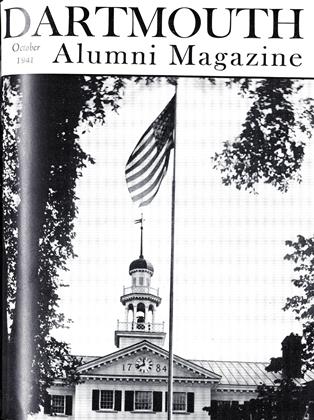by Elmore Peterson and E.Grosvenor Plowman '20, Richard D. Irwin,1941, 656 pp. $4.00.
THE AUTHORS of this book need offer no apologies for their part in the expenditure of white paper and printer's ink which publication of the book entailed. They have done a splendid job, on the whole. Avoiding the easy task,—to write another book on management, with a few up-to-date starts and figures, they assigned themselves a difficult task: to furnish the schools of business administration with a text-book that analyzes functions and processes, to the end that the student may be helped to gain the thing most needful,—experience in analyzing, interpreting, and appraising. This experience he can secure in the college classroom; most of his other experience he must obtain on the job.
The reader will look in vain for the traditional sections on plant location, purchasing, production, forms of business organization, industrial relations. Instead, he finds a discussion of departmentalization, authority, accountability, centralization, efficiency, leader- ship. The terms listed in the table of contents would, I imagine, stagger the average student in the School of Business, not by their strangeness—they are familiar enough—but by their scope and reach. But the authors assume that their book will be used by sober, sophisticated men, and they do not hesitate to ask the reader to grapple with difficult ideas.
The authors themselves occasionally do more grappling than seems necessary, and at times with little success. While reading the chapter entitled, "Effective Leadership," I felt as though I were driving around in one of those enormous traffic circles in New Jersey: I knew that I had gotten in, and I felt that eventually I would get out, but meanwhile the general pattern was that of a maze. One of the paragraph headings, "Purchasing Merchandise for Resale vs. Leadership," was as bewildering as any traffic sign I ever saw in one of the aforesaid mazes!
But such criticism is carping when you consider what the authors tried to do, and how well they succeeded, by and large. Their book is a challenege to the student, and an equal challenge to the teacher; both are honored by the author's assumption that each will be equal to his share of a difficult assignment.
In one sense, a very literal sense—the book is heavier than it needs to be. The publisher must have combed the marts of the world for materials of the greatest possible specific gravity. The result is a book weighing three pounds; hold it for an hour while you read, and you'll think it weighs a stone. There ought to be a law.
 View Full Issue
View Full Issue
More From This Issue
-
 Article
ArticleDartmouth Again Faces A World Crisis
October 1941 By WM. STUART MESSER -
 Article
ArticleFavorable Financial Year
October 1941 By Alumni Fund and Over Two Millions Added to Assets -
 Article
ArticleCollege Opens With Convocation Address
October 1941 -
 Class Notes
Class Notes1917*
October 1941 By EUGENE D. TOWLER, DONALD BROOKS -
 Class Notes
Class Notes1912*
October 1941 By CONRAD E. SNOW, RICHARD C. PLUMER -
 Article
ArticleOut-Of-Doors Disciple
October 1941 By ROSS McKENNEY
Books
-
 Books
BooksALUMNI PUBLICATIONS
April, 1925 -
 Books
Booksshelflife
Jan/Feb 2013 -
 Books
BooksNORTHLAND ADVENTURE.
October 1954 By CLIFF JORDAN '45 -
 Books
BooksPREMIER MANUEL. GRAMMAIRE ET CIVILISATION FRANCAISES.
November 1954 By FRANCOIS DENOEU -
 Books
BooksLABOR'S SEARCH FOR MORE
May 1937 By Hugh L. Elbree -
 Books
BooksHENRY BARNARD
May 1938 By R. A. Burns


